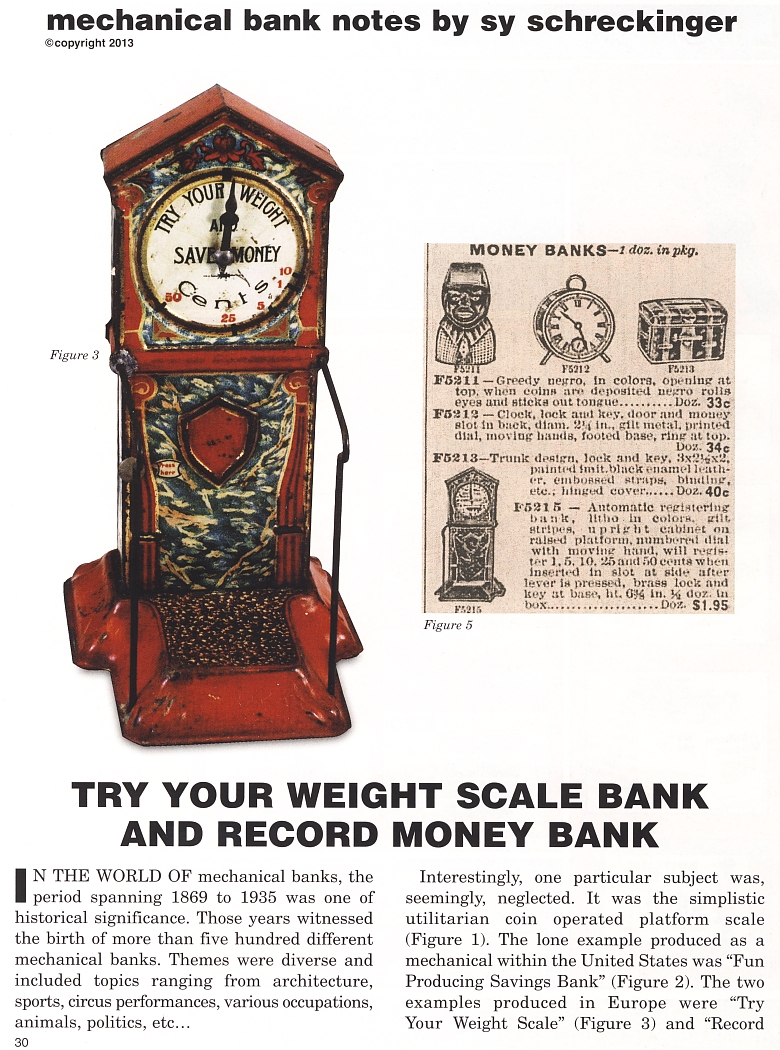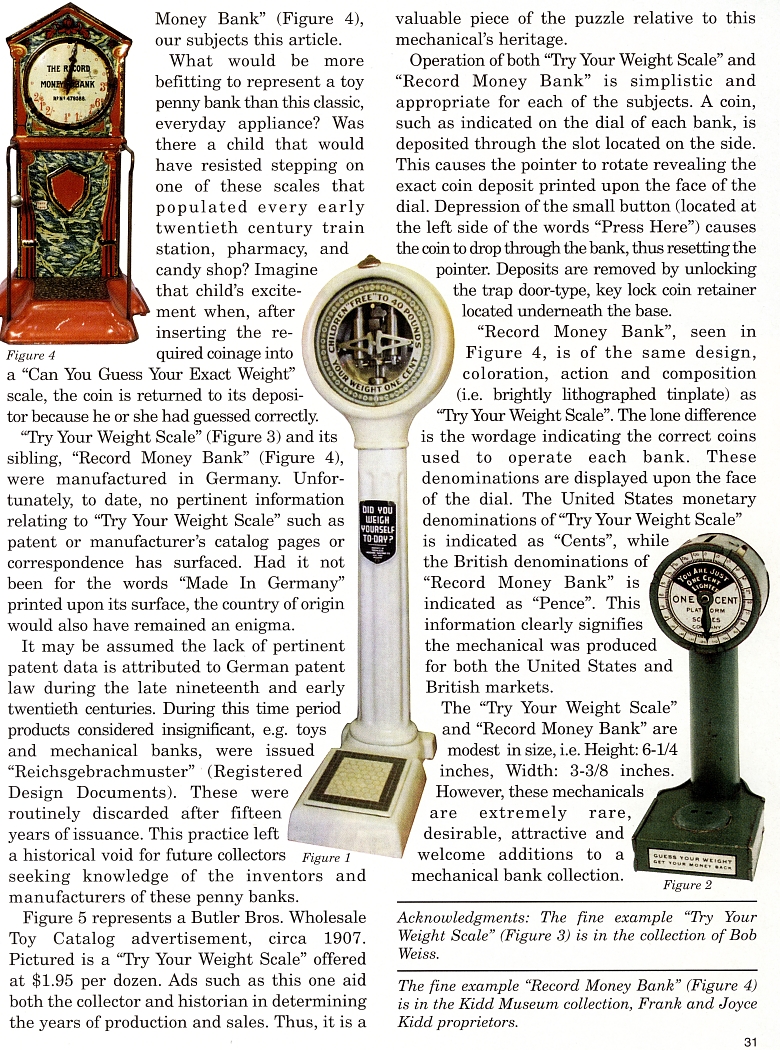|
TRY YOUR WEIGHT SCALE
AND RECORD MONEY BANK
by Sy Schreckinger – ANTIQUE TOY WORLD Magazine –
July, 2013
IN THE
WORLD OF mechanical banks, the period spanning 1869 to 1935 was one of
historical significance. Those years witnessed the birth of more than
five hundred different mechanical banks. Themes were diverse and
included topics ranging from architecture, sports, circus performances,
various occupations, animals, politics, etc...
Interestingly, one particular subject was, seemingly, neglected. It
was the simplistic utilitarian coin operated platform scale (Figure 1).
The lone example produced as a mechanical within the United States was
"Fun Producing Savings Bank" (Figure 2). The two examples produced in
Europe were "Try Your Weight Scale" (Figure 3) and "Record Money Bank"
(Figure 4), our subjects this article.
What would be more befitting to represent a toy penny bank than
this classic, everyday appliance? Was there a child that would have
resisted stepping on one of these scales that populated every early
twentieth century train station, pharmacy, and candy shop? Imagine that
child's excitement when, after inserting the required coinage into a
"Can You Guess Your Exact Weight" scale, the coin is returned to its
depositor because he or she had guessed correctly.
"Try Your Weight Scale" (Figure 3) and its sibling, "Record Money
Bank" (Figure 4), were manufactured in Germany. Unfortunately, to date,
no pertinent information relating to "Try Your Weight Scale" such as
patent or manufacturer's catalog pages or correspondence has surfaced.
Had it not been for the words "Made In Germany" printed upon its
surface, the country of origin would also have remained an enigma.
It may be assumed the lack of pertinent patent data is attributed
to German patent law during the late nineteenth and early twentieth
centuries. During this time period products considered insignificant,
e.g. toys and mechanical banks, were issued "Reichsgebrachmuster"
(Registered Design Documents). These were routinely discarded after
fifteen years of issuance. This practice left a historical void for
future collectors seeking knowledge of the inventors and manufacturers
of these penny banks.
Figure 5 represents a Butler Bros. Wholesale Toy Catalog
advertisement, circa 1907. Pictured is a "Try Your Weight Scale" offered
at $1.95 per dozen. Ads such as this one aid both the collector and
historian in determining the years of production and sales. Thus, it is
a valuable piece of the puzzle relative to this mechanical's heritage.
Operation of both "Try Your Weight Scale" and "Record Money Bank"
is simplistic and appropriate for each of the subjects. A coin, such as
indicated on the dial of each bank, is deposited through the slot
located on the side. This causes the pointer to rotate revealing the
exact coin deposit printed upon the face of the dial. Depression of the
small button (located at the left side of the words "Press Here") causes
the coin to drop through the bank, thus resetting the pointer. Deposits
are removed by unlocking the trap door-type, key lock coin retainer
located underneath the base.
"Record Money Bank", seen in Figure 4, is of the same design,
coloration, action and composition (i.e. brightly lithographed tinplate)
as "Try Your Weight Scale". The lone difference is the wordage
indicating the correct coins used to operate each bank. These
denominations are displayed upon the face of the dial. The United States
monetary denominations of "Try Your Weight Scale" is indicated as
"Cents", while the British denominations of "Record Money Bank" is
indicated as "Pence". This information clearly signifies the mechanical
was produced for both the United States and British markets.
The "Try Your Weight Scale" A and "Record Money Bank" are j modest
in size, i.e. Height: 64/4 inches, Width: 3-3/8 inches. However, these
mechanicals are extremely rare, desirable, attractive and welcome
additions to a mechanical bank collection.
Acknowledgments: The fine example "Try Your Weight Scale" (Figure
3) is in the collection of Bob Weiss. The fine example "Record Money
Bank" (Figure 4) is in the Kidd Museum collection, Frank and Joyce Kidd
proprietors. |


